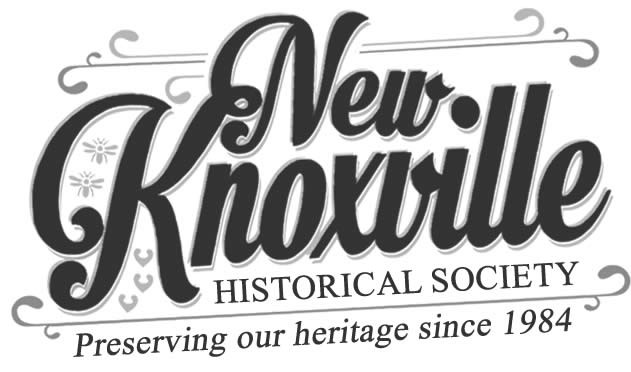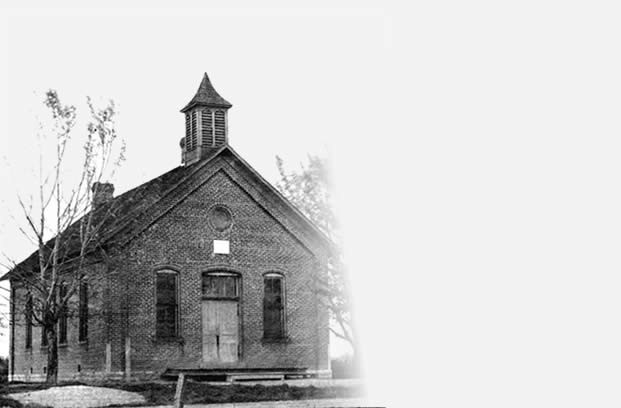(From the 1923 History of Auglaize County, William J. McMurray, Editor)
Washington township on the southern border of Auglaize County in the second row of townships from the west is made up of thirty sections (1-30) of township 6 south, range 5 east, five miles north and south and six miles east and west, and thus has thirty square miles of as choice lands as are found in the county. The township is bordered on the north by Moulton township, on the east by Pusheta township, on the south by Shelby county and on the west by St. Mary's township, with the village of New Knoxville occupying three-fourths of a mile square in the southwest corner of the township in sections 19, 20, 29 and 30. The Western Ohio Electric railway cuts across the extreme northwest corner of the township, following the line of the St. Marys-Wapakoneta highway (the old plank road), and is the only railway line in the township.
Washington township is admirably situated so far as its natural drainage features are concerned, being traversed by Center creek, Clear creek and Muddy creek, tributaries of the St. Marys, and Owl creek, a tributary of the Auglaize, these with their branches being supplemented by an ample and adequate system of ditches and drains, so that there is practically no waste land in the township. From a soil survey it is noted that the soil of this township is generally black sandy loam, intermixed with clay and gravel. The fertile bottom lands along the numerous lateral streams make it one of the best agricultural sections of the county. These lands, it has been observed, as in all other parts of the county, were heavily wooded, "and the improvements that are to be noted at the present time are the results of the most arduous toil." The timber of the township is of the usual varieties indigenous to this region, such as hard maple, beech, elm, ash, oak, walnut, linden, hickory, hackberry, buckeye, etc. Upon the development of the local gas and oil field this township profited greatly by the numerous profitable wells opened within its territory and there still is profitable production of oil in parts of the township.
Washington township was formerly attached to Allen County for civil purposes and was given a separate civil entity late in the year 1836, the journal of the board of commissioners for Allen County as of December 1, 1836, noting that on petition of resident citizens in town 6 south, range 5 east, it was "ordered that a new township be erected, to be designated and known by the name of Washington. It was further ordered that legal notices should be posted up in the new township of Washington for the election of township officers, said election to be held at the dwelling house of George Esperson on the 20th day of December, 1836." The Wapakoneta Indian reservation took in a little more than the northeast quarter of this township, and there thus was little settlement here until after the departure of the Indians in 1832. There had, however, prior to that departure been several entries of lands in that portion of the township not comprised within the reservation, the tract book showing the presence here in 1831 of Shadrach Montgomery, William Spray, Thomas Chambers and Samuel McCullough; and in 1832, of Ephraim McKinney, Samuel Stabler, Samuel Howell, John Campbell and Ebenezer Lucas, and by the time the township was organized in 1836 pretty much all the most desirable land had been taken up.
When the tide of German emigration set in this way these lands attracted the attention of many persons of this nativity and in time the population of the township became predominately German in stock, the first church in the township having been erected in 1838 by the German Reformed residents who had settled in the Knoxville neighborhood. In 1858, twenty-two years following the formal platting of the townsite of Knoxville, which when a post office was established there had to take a new name there being another Knoxville in the state (in Jefferson County), and conformed to regulations by prefixing "New" to the original name, since which time it has been New Knoxville.
In connection with the early settlement of this township, special mention is due the name and services of Shadrach Montgomery, who entered his land there in 1831 and early became an influential factor in the development of the new country. Mr. Montgomery, a soldier of the War of 1812, was a Pennsylvanian by birth who had moved over into Ohio after his marriage and settled in Champaign county, where he remained until 1830, when he came up here on a prospecting trip and liked the lay of the land so well that in the following year he entered claim to a tract of land between Clear creek and Owl creek, just below the Indian reservation line, in what is now section 24 of Washington township, and there established a new home in the wilderness, the first permanent white settler in the township. He assisted in the organization of the township in 1836 and in 1842 was elected a member of the board of county commissioners for Allen County.
When Auglaize County was erected in 1848 Mr. Montgomery Was elected a member of the first board of county commissioners and thus helped to organize the new county. He was a great hunter and is said to have killed the last deer and the last wolf seen in this county. Mr. Montgomery died in the fall of 1871, being then past eighty-two years of age. He was indeed one of the "fathers" of the county.
When Auglaize county was erected in 1848 there were the following landowners in Washington township, as revealed by the tax duplicate for that year: Bernard Afferth, Jacob Arnett, John Arnett, Demas Adams, Jonathan Bolander, John Bates, Gotlieb Burke, William Burton, Case Broderick, Lewis Brocksick, Robert Brannum, J V. Brunner, Samuel Blakesley, Mary Braman, David Catterdon, Charles Cumings, Robert Cathcart, William Cook, Jacob Coverston, Gordon Cecil, Spencer Cole, John L. Campbell, H. H. Conklin, Hollister Cole, Cottril Gershom, Malcolm Campbell, William Casad, Thomas Carey, Joseph Campbell, Morgan Copsey, George Copsey, William Copsey, George Deigle, Henry Fledderjohan, Adam Fledderjohan, William Fledderjohan, Christian Forney, Joel Fuller, Henry Frische, Jacob Fike, John Frounfelter, Thomas Flowers, Ignatz Fisher, Daniel Gerhart, Henry Green, Henry Gudorf, Stratton Gorham, Adolph Haverkamp, Jacob Hudson, Henry Hoelscher, Jefferson Howell, Bernard Harmer, Jacob Hover, John M. Howell, Benjamin Hawkins, Jesse Hudson, William Hudson, Jesse Hudson, Sr., Christopher Harvey, H. Hicks, Jonathan Hankins, Mary Hall, George Holtzbecker, Benjamin Julian, William Jackson, Anna Koler, William Kuck, John Kitchen, Henry Kruse, Thomas Keiser, J. W. Lutterbeck, Abraham Long, Henry Lutterbeck, Frederick Leathers, Ebenezer Lucas, James T. Luttrell, W. H. J. Lambers, John Miller, J. E. McFarland, Henry Miller, Jacob Miller, William, Adam, Herman and Henry Meckstroth, Shadrach Montgomery, Samuel McCullough, Frederick Marquand, Cord Meyer, Robert McMurray, Peter D. Mellinger, H. H. Neimeyer, Charles F. Oswald, John Powell, Samuel Pence, William Pence, Joseph Patton, Benjamin Powell, George Roberts, Charles Route, Isaac Rhodes, John Roberts, William Redwilliam, Sarah Roberts, Rebecca Roberts, Jesse Roberts, William Ryan, Zachariah Ryan, Elijah Ryan, John Rodeheifer, Elvira Ritter, Jacob Rolle, Mathias, Solomon, Julian and Benjamin Saum, Henry Shannahan, Philip Stilway, J. H. Schraver, Casper Smith, H. W. Sunderman, Conrad and John Stroth, John Straw, Benjamin Stiles, Martin Schade, Isaac Sheets, Henry Shearer, J. Smith, J. B. Tobias, Christian Tobias, John Tailing, Henry Vanneman, Dominicus Vandever, Frederick Wellman, John Wiley, Jefferson A. Walters, Boiles Wirck, Henry Wellman, James J. Wilkins, Daniel Woodruff, V. H. Weaver, Mahlon Wahl, Nehemiah York and John Younger.
In the town of Knoxville (New Knoxville) in this township there then were listed the following lot owners: Andrew Atkinson, John Bosche, B. and S. Brown, Henry Fluke, B. H. Horn, Frederick Leathers, Samuel Long, Cord Meyer, Charles Route, J. G. Strausburg and B. F. Schroeder.
New Knoxville, which is situated on the left bank of the Center fork of the St. Marys river in the southwestern corner of Washington township, in the northwest corner of section 29 and the northeast corner of section 30, was platted as a townsite under the name of Knoxville and this plat was filed for record in the office of the recorder of Allen county on July 30, 1836, by the proprietor of the townsite, James K. Lytle, who at that time was operating the mill at that point and very properly had come to the conclusion that this mill and the adjoining store would serve as a nucleus for a village. Lytle had bought this mill from Cummins, Mather & Brown, who had established it, and who upon selling the mill had opened a store, thus opening a trading center as well as a milling point, and it was not long until quite a nice little hamlet had sprung up there, this having developed during the years until the census report for 1920 now gives it a population of 537, with all the conveniences of a modern village save railway connection, the town having the usual complement of stores and industries and a bank. The town was incorporated in 1874.
High praise for the go-ahead qualities of the people of this progressive village was paid in Meyer's atlas of Auglaize county (1917), which said that "in the writer's opinion New Knoxville is the best kept and most beautiful small town he has ever seen. Its streets are all nicely graded and drained; its sidewalks compare favorably with those of many cities. There seems to be something in the spirit of its inhabitants which keeps them alive to progressive ideas and gives them the courage to use these ideas in the conduct of the village and its improvements." A modern school building was erected in 1915 at a cost of about $18,000 and the admirable architectural features of the churches there add further attractiveness to the town. The original plat of the town carries 102 lots, eleven full squares and three fractional squares, with the cemetery in the southwestern corner of the plat. This plat is bounded on the north by Spring Street, on the east by East Street, on the south by South Street and on the west by West Street, with Mill, Main and St. Marys streets as the intermediate north and south streets and Bremen and German as the intermediate east and west streets. The Peoples Savings Bank of New Knoxville was organized in 1910. The current bankers' directory shows the bank to be capitalized at $12,000, with surplus and profits aggregating $9,000; deposits of $301,770 and resources in excess of $330,000. The president of this bank is Herman Kuhlman and the cashier is H. H. Kuhlman.
NOTE: Some erroneous information from the original copy has been corrected, and the spelling of some names is questionable.


